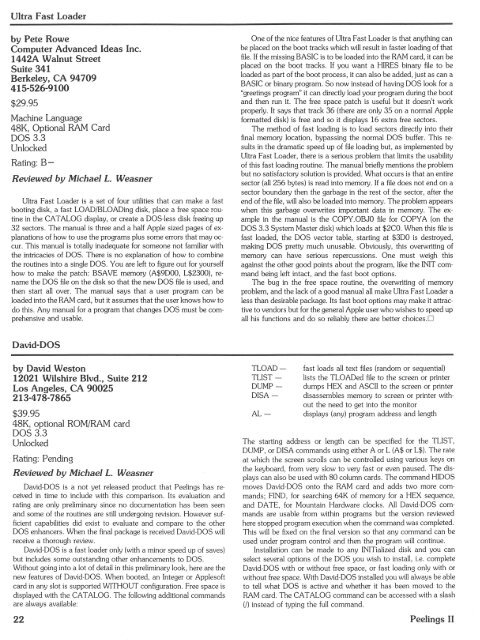You also want an ePaper? Increase the reach of your titles
YUMPU automatically turns print PDFs into web optimized ePapers that Google loves.
Ultra Fast Loaderby Pete RoweComputer Advanced Ideas Inc.1442A Walnut StreetSuite 341Berkeley, CA 94709415-526-9100$29.95Machine Language48K, Optional RAM CardDOS 3.3UnlockedRating: B-Reviewed by Michael L. WeasnerUltra Fast Loader is a set of four utilities that can make a fastbooting disk, a fast LOAD/BLOADing disk, place a free space routinein the CATALOG display, or create a DOS-less disk freeing up32 sectors. The manual is three and a half Apple sized pages of explanationsof how to use the programs plus some errors that may occur.This manual is totally inadequate for someone not familiar withthe intricacies of DOS. There is no explanation of how to combinethe routines into a single DOS. You are left to figure out for yourselfhow to make the patch: BSAVE memory (A$9DOO, L$2300), renamethe DOS file on the disk so that the new DOS file is used, andthen start all over. The manual says that a user program can beloaded into the RAM card, but it assumes that the user knows how todo this. Any manual for a program that changes DOS must be comprehensiveand usable.One of the nice features of Ultra Fast Loader is that anything canbe placed on the boot tracks which will result in faster loading of thatfile. If the missing BASIC is to be loaded into the RAM card, it can beplaced on the boot tracks. If you want a HIRES binary file to beloaded as part of the boot process, it can also be added, just as can aBASIC or binary program. So now instead of having DOS look for a"greetings program" it can directly load your program during the bootand then run it. The free space patch is useful but it doesn't workproperly. It says that track 36 (there are only 35 on a normal Appleformatted disk) is free and so it displays 16 extra free sectors.The method of fast loading is to load sectors directly into theirfinal memory location, bypassing the normal DOS buffer. This resultsin the dramatic speed up of file loading but, as implemented byUltra Fast Loader, there is a serious problem that limits the usabilityof this fast loading routine. The manual briefly mentions the problembut no satisfactory solution is provided. What occurs is that an entiresector (all 256 bytes) is read into memory. If a file does not end on asector boundary then the garbage in the rest of the sector, after theend of the file, will also be loaded into memory. The problem appearswhen this garbage overwrites important data in memory. The examplein the manual is the COPY.OBJO file for COPYA (on theDOS 3.3 System Master disk) which loads at $2CO. When this file isfast loaded, the DOS vector table, starting at $3DO is destroyed,making DOS pretty much unusable. Obviously, this overwriting ofmemory can have serious repercussions. One must weigh thisagainst the other good points about the program, like the !NIT commandbeing left intact, and the fast boot options.The bug in the free space routine, the overwriting of memoryproblem, and the lack of a good manual all make Ultra Fast Loader aless than desirable package. Its fast boot options may make it attractiveto vendors but for the general Apple user who wishes to speed upall his functions and do so reliably there are better choices.DDavid-DOSby David Weston12021 Wilshire Blvd., Suite 212Los Angeles, CA 90025213-478-7865$39.9548K, optional ROM/RAM cardDOS 3.3UnlockedRating: PendingReviewed by Michael L. WeasnerDavid-DOS is a not yet released product that Peelings has receivedin time to include with this comparison. Its evaluation andrating are only preliminary since no documentation has been seenand some of the routines are still undergoing revision. However sufficientcapabilities did exist to evaluate and compare to the otherDOS enhancers. When the final package is received David-DOS willreceive a thorough review.David-DOS is a fast loader only (with a minor speed up of saves)but includes some outstanding other enhancements to DOS.Without going into a lot of detail in this preliminary look, here are thenew features of David-DOS. When booted, an Integer or Applesoftcard in any slot is supported WITHOUT configuration. Free space isdisplayed with the CATALOG. The following additional commandsare always available:22TLOADTLISTDUMPDISA-ALfastloads all text files (random or sequential)lists the TLOADed file to the screen or printerdumps HEX and ASCII to the screen or printerdisassembles memory to screen or printer withoutthe need to get into the monitordisplays (any) program address and lengthThe starting address or length can be specified for the TLIST,DUMP, or DISA commands using either A or L (A$ or L$). The rateat which the screen scrolls can be controlled using various keys onthe keyboard, from very slow to very fast or even paused. The displayscan also be used with 80 column cards. The command HIDOSmoves David-DOS onto the RAM card and adds two more commands;FIND, for searching 64K of memory for a HEX sequence,and DA TE, for Mountain Hardware clocks. All David-DOS commandsare usable from within programs but the version reviewedhere stopped program execution when the command was completed.This will be fixed on the final version so that any command can beused under program control and then the program will continue.Installation can be made to any IN!Tialized disk and you canselect several options of the DOS you wish to install, i.e. completeDavid-DOS with or without free space, or fast loading only with orwithout free space. With David-DOS installed you will always be ableto tell what DOS is active and whether it has been moved to theRAM card. The CATALOG command can be accessed with a slash(/) instead of typing the full command.Peelings II

















